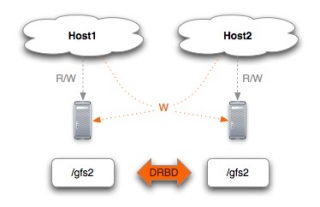
GFS2 – the Global File System
Very responsive on large files.
It allows a cluster of computers to simultaneously use a block device that is shared between them (with FC, iSCSI, NBD, etc…). GFS reads and writes to the block device like a local filesystem, but also uses a lock module to allow the computers coordinate their I/O so filesystem consistency is maintained.
OCFS2 – stands for Oracle Cluster File System
Very fast with large and small files on different node with two types of performance models (mail, datafile)
Some of the notable features of the file system are:
* Optimized Allocations (extents, reservations, sparse, unwritten extents, punch holes)
* REFLINKs (inode-based writeable snapshots)
* Indexed Directories
* Metadata Checksums
* Extended Attributes (unlimited number of attributes per inode)
* Advanced Security (POSIX ACLs and SELinux)
* User and Group Quotas
* Variable Block and Cluster sizes
* Journaling (Ordered and Writeback data journaling modes)
* Endian and Architecture Neutral (x86, x86_64, ia64 and ppc64)
* Buffered, Direct, Asynchronous, Splice and Memory Mapped I/Os
* In-built Clusterstack with a Distributed Lock Manager
* Cluster-aware Tools (mkfs, fsck, tunefs, etc.)

Leave a Reply